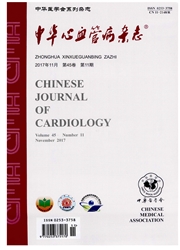

 中文摘要:
中文摘要:
目的通过观察血管内皮生长因子(VEGF)缓释明胶微球与自体骨髓间充质干细胞(MSC)联合移植于猪心肌梗死模型梗死周边区3周后MSC的生存情况,结合磁共振成像(MRI),阐明改善局部微环境对自体MSC移植于缺血心肌后转归的影响,并直观评价MRI对移植MSC在体示踪及半定量分析的可靠性。方法以乳化冷凝法制备VEGF缓释明胶微球并评价其缓释性能。成年中华小型猪12头,抽取髂骨骨髓并制备自体MSC,以顺磁性氧化铁颗粒(SPIO)和4′,6-二脒基-2-苯基吲哚(4′,6-Diamidino-2-phenylindole dihydrochloride,DAPI)标记细胞。按照随机化表将动物分为MSC移植组及MSC-VEGF缓释微球联合移植组。开胸结扎冠状动脉左前降支制备小型猪心肌梗死模型后第14天,直视下经心外膜于MSC组动物心肌梗死周边区注射MSC(9×10^7),于MSC-VEGF缓释微球组注射MSC(9×10^7)及VEGF缓释明胶微球(含9μg人重组VEGF165)。细胞和(或)微球移植后24h及21d,磁共振FGRE序列T2^*像检测干细胞移植点低信号区的面积及信号强度。病理组织学检测细胞移植区域心肌组织毛细血管密度及干细胞存活情况。结果明胶微球平均粒径为(104.0±22.6)μm,体内、外缓释VEGF均可达到10d以上。小型猪心肌梗死模型建立后第14天,梗死区面积为33.6%±8.9%。细胞移植后24h,MSC注射点于MRI显示为边界清晰的卵圆形T2^*低信号区,细胞移植3周后,两组注射点T2^*低信号区面积均减小(P〈0.05),其与正常心肌组织间的信号对比度均减低(P〈0.05)。MSC-VEGF缓释微球组移植点毛细血管密度高于MSC组[(15.2±5.4)个/高倍视野比(10.2±5.0)个/高倍视野,t=2.43,P〈0.05]。MSC-VEGF缓释微球组MSC注射点移植细胞数多于MSC组[(354±83)个/高倍视野比(278±97)个/高倍视野,t=3.14,P〈0.05],而MSC凋?
 英文摘要:
英文摘要:
Objective To investigate the efficacy of transplantation of mesenchymal stem cells (MSC) with gelatin microspheres containing vascular endothelial growth factor in ischemic regions in infracted swine hearts. Methods Twelve Chinese mini swines with infarction were randomized to receive autogenetic MSC injection to the peri-infarction area of left ventricular wall (MSC group, n = 6) or MSC transplantation with gelatin hydrogel microspheres incorporating vascular endothelial growth factor (VEGF- MSC group, n = 6). Three weeks later, left ventricular function was assessed by magnetic resonance imaging (MRI). The contrast of the MSC hypointense lesion was determined using the difference in signal intensity between the hypointense and normal myocardium divided by signal intensity of the normal region. Myocardial capillary density, the number of DAPI positive MSC and the apoptotic MSC were also determined. Results The diameter of the microspheres averaged ( 104.0 ±22.6)μm. At 24 hours after transplantation, MSC were identified by MRI as large intramyocardial signal voids at injection sites which persisted up to 3 weeks. There was no significant difference in the contrast of the lesions and in the size of the lesions at 24 hours between two groups. At 3 weeks after injection, the size of the lesions and the contrast of the lesion were decreased (P 〈 0. 05 ) in both groups. The capillary density of the injection site was significantly more in the MSC-VEGF microsphere group than that in MSC group [ ( 15.2 ± 5.4)/HPF vs. ( 10. 2 ± 5.0)/HPF, t = 2.43, P 〈 0. 05 ] , and there were more dense DAPI labeled MSC per high power fields in injection sites of MSC-VEGF microsphere group than that in MSC group [ (354 ±83)/HPF vs. (278 ±97)/HPF, t =3. 14, P 〈0. 05]. Moreover, the apoptosis rate of MSCs of MSCs-VEGF microsphere group was less than that of MSCgroup [(6.4 ±4.1)% vs. (11.9± 4.8)%, t = 2.97, P 〈 0.05]. Conclusions MSC transplantation with gelatin hydrogel micro
 同期刊论文项目
同期刊论文项目
 同项目期刊论文
同项目期刊论文
 期刊信息
期刊信息
